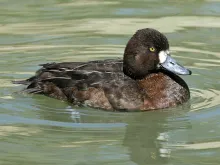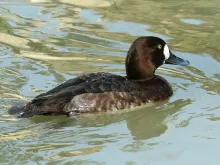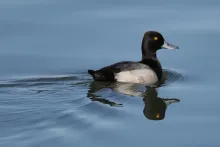
Lesser Scaup (Aythya affinis)
Species name
- Dutch name:
- Kleine toppereend
- English name:
- Lesser Scaup
- German name:
- Veilchenente
- French name:
- Petit Fuligule
- Scientific name:
- Aythya affinis
Scientific classification
- Order:
- Anseriformes
- Family:
- Anatidae
- Onderfamilie:
- Aythyinae
- Genus:
- Aythya
Description
- Description:
Male:
Male lesser scaup have a glossy black head with purple iridescents sheen. (* Note: Some well have green as Greater Scaup Iridescents on Head not always best way to ID Lesser Scaup ) . The neck, breast, and upper mantle are glossy black. Vermiculations on the sides and flanks are olive-brown and contrast with the white chest and belly. The back is light gray with broad heavy vermiculations of sooty black. The tail, upper and under-tail coverts are black. The wing has a white speculum and the inner primaries are light brown, becoming darker towards the tips and outer primaries. The bill is a light blue-gray with a black nail, the legs and feet are gray, and the iris is yellow.Female:
The females have a brownish head, neck, and chest, and white oval patches around their bills. The back, rump, and scapulars are dark brown and the speculum is white. The bill is similar to that of the male, but slightly duller, the legs and feet are gray, and the iris is yellow.Juvenile:
The juvenile is mostly identical as female but smaller white around base of bill and more pale brown, less vermiculated grey throughout body.
Standard Measurements
- Body Length (cm):
- The male (drake) of the Lesser Scaup measures approximately 38–48 centimeters. The female measures approximately 38–48 centimeters.
- Body Weight (grams):
- The male will weight about 690–1085 gram. The female will weight about 680– 950 gram.
The weight is notoriously variable and can only be used as indication!
- Note:
Lesser scaups are diving ducks which spend most of their time on water, and are ungainly on land. They are generally hardy, sociable and easy to maintain in captivity. They should be kept with deep water available for diving, three to seven feet suggested, or at least half the area 60cm and preferably one metre deep, with shallow sloping banks for easy exit from the water, also islands, good marginal vegetation and loafing areas. Water providing a good supply of natural animal and vegetable food is preferred.
These ducks may be kept in mixed collections with dabbling ducks, including smaller species such as teal. They should be fed wheat in water, encouraging their natural diving behaviour. Pellets should also be fed. They may breed better if a group rather than single pair kept, as this allows their normal group displaying activity.
30x30x35cm nest box with 12.5cm entrance hole suggested, placed under cover at the edge of the pond.
Lesser scaup are easy to manage; breeding is most likely on large lakes.
These ducks are fairly easy to breed. Nests are well concealed in vegetation on islets (preferred) or shores, eggs usually laid in June. Hand-rearing under heat lamp suggested.
Hybridise easily with other Aythya spp., particularly Greater scaup (Aythya marila) with which fertile hybrids are produced.
- Breeding:
- The female Lesser Scaup usually lays from 9-11 creamy white eggs and incubates them for 24 days.
- Artificial incubating:
The ideal relative humidity for incubating most waterfowl eggs is 55% (ground nesters) and 40% (cavity nesters). The temperature is usually 37.4°C. Set ventilation as recommended by the incubator manufacturer. Eggs must be turned, either automatically or by hand, a minimum of 4 times a day. As the duckling develops there is a loss of water from the egg and the air sac gets bigger. In normal development of an egg with a 24 days incubation, the air sac occupies about a third of it three days earlier. Cleanliness is vital and ideally eggs should be moved to a separate hatcher at this point, where the humidity should be increased to 65% and even higher once they have pipped internally.
- Bird banding:
- Recommended closed leg band ring size for the Lesser Scaup is 9 mm.The leg band ring can only be applied on a young diving duck at around 12 days old.
- It doesn't matter what leg that you band, but it's good to have a consistent system. Suggested: Left leg = Female, Right leg = Male
- Maintenance food:
-



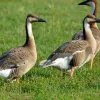

Lundi Regular with a protein content of 20%, valuable Spirulina and high-quality by-products is optimally balanced in its composition maintenance food for water ornamental fowl of all kinds. Especially green teal and Whistling ducks that are not dependent on a very high protein content, are well supplied.
Lundi Regular contains all the minerals and vitamins in full form that are important for the animals. Therefore also suitable as breeding food.


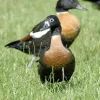


Floating full food for all sea ducks, green ducks, eider ducks and geese, especially in the moulting and breeding phase ideally suited. Packed with wholesome raw materials, natural vitamins and trace elements, this performance food with a protein content of 30% forms the basis for lifelong vitality.
- Regulation:
- Europese soort
- Regulation:
Het is niet verboden om deze vogels te houden die van nature in Nederland voorkomen, op voorwaarde dat deze vogels in gevangenschap zijn geboren; nakweek dus. Deze vogels zijn voorzien van een gesloten pootring. Het is wel verboden om deze vogels te houden die in het wild gevangen zijn. Alleen bepaalde instanties, zoals vogelasiels en vogelhospitalen, zijn bevoegd om jonge en gewonde wilde vogels te houden. Deze bescherming van vogels wordt vormgegeven door schadelijke handelingen te verbieden zoals:het doden, verwonden, vangen, bemachtigen en met het oog daarop opsporen van vogels (art. 9 Flora- en faunawet); het opzettelijk verontrusten van vogels (art. 10 Flora- en faunawet);het beschadigen, vernielen, uithalen, wegnemen en verstoren van nesten, holen of andere voortplantings- of vaste rust- of verblijfplaatsen van vogels (art. 11 Flora- en faunawet);en het zoeken, rapen, uit het nest nemen, beschadigen of vernielen van eieren van vogels (art. 12 Flora- en faunawet).
